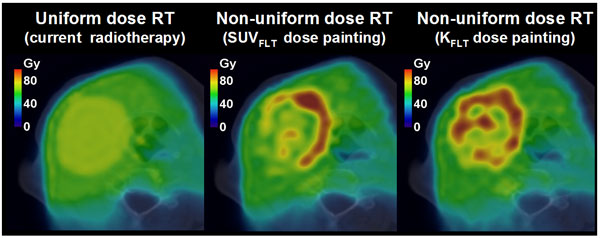News Release
SCIENCE HIGHLIGHTS of the 50th AAPM Meeting in Houston, July 27 to July 31
4. ATTACKING TUMORS BIT BY BIT

Currently, doses delivered to tumors are uniform, neglecting inherent tumor biological structure (left).
With advanced knowledge of tumor radioresistance extracted from molecular imaging,
delivery of non-uniform doses (dose painting) could lead to improved tumor control.
Proper extraction of biologically relevant information from molecular imaging is of utmost
importance, because it can lead to significantly different treatments (middle, right).
[Image was
created by Urban Simoncic from IJS and by Dr. Robert Jeraj from
UW-Madison]
Not all parts of a tumor respond to radiation therapy in the same way. Treatments in the future may target the most resistant tumor regions, but measuring this resistance is far from straightforward, a new analysis shows.
Common radiation therapy prescribes a uniform radiation dose to the entire tumor, even though it is commonly known that some regions resist radiation more than others. Researchers are therefore experimenting with ways to tailor the treatment, with so-called "dose painting," so that more radiation falls on the radio-resistant parts.
For this to be effective, radio-resistance must be well-defined at the molecular level. This presumably can be done with PET scans using the radio-tracer FLT (fluoro-L-thymidine). When injected into the body, FLT is grabbed up by cells in the process of cell division. Therefore, rapidly-dividing cancer cells will look bright in a PET scan. Once treatment is started, those cells that remain bright would be considered radio-resistant, i.e. the radiation is not affecting their activity. But this simple brightness measure, called a standardized uptake value (SUV), is not the only way to locate non-responsive cells in a PET image. A more precise way (based on a parameter called KFLT) is to model how the radio-tracer travels through the body and is taken up by cells over time.
Urban Simoncic (urban.simoncic@ijs.si) of the Institut Jozef Stefan in Ljubljana, Slovenia, together with collaborators from University of Wisconsin-Madison compared the SUV and KFLT techniques on the exact same sets of PET scans and found that the two selected out different regions as being radio-resistant. This implies that a dose painting treatment based on one model would differ significantly from that based on the other. The researchers believe the community needs to address this discrepancy with more careful clinical investigation.
Talk (MO-E-AUD C-1), "Dosimetric Differences for Dose Painting, Based On SUV Or KFLT FLT-PET Image Ratio" is at 4:00 p.m. on Monday July 28, 2008 in Auditorium C. Abstract: http://www.aapm.org/meetings/amos2/pdf/35-9061-97759-696.pdf.
****************************************************************RELATED LINKS
- AAPM home page: http://www.aapm.org
- Abstracts and search form: http://www.aapm.org/meetings/08AM/MeetingProgram.asp
- Press Guide: http://www.aapm.org/meetings/08AM/VirtualPressRoom/
- Background article about how medical physics has revolutionized medicine:
http://www.newswise.com/articles/view/538208/
HOW TO COVER THE MEETING
Reporters who would like to attend the meeting in person should fill out the press registration form on the AAPM Virtual Press Room. See: http://www.aapm.org/meetings/08AM/VirtualPressRoom/documents/pressregform.pdf.
Reporters who would like to cover the conference remotely will find releases and articles on the Virtual Press Room highlighting many of the interesting and important talks presented at the meeting. Even if you can't make it to Houston, the Virtual Press Room will make it possible to write stories about the meeting from your desk.
ABOUT AAPM
The American Association of Physicists in Medicine (AAPM) is a scientific, educational, and professional nonprofit organization whose mission is to advance the application of physics to the diagnosis and treatment of human disease. The association encourages innovative research and development, helps disseminate scientific and technical information, fosters the education and professional development of medical physicists, and promotes the highest quality medical services for patients. In 2008, AAPM will celebrate its 50th year of serving patients, physicians, and physicists. Please visit the association's Web site at http://www.aapm.org/.
ABOUT AIP
Headquartered in College Park, MD., the American Institute of Physics is a not-for-profit membership corporation chartered in New York State in 1931 for the purpose of promoting the advancement and diffusion of the knowledge of physics and its application to human welfare.
####
Media contacts:
Jason Socrates Bardi, American Institute of Physics,
301-209-3091 (office) 858-775-4080 (cell)
jbardi@aip.org
Jeff Limmer, AAPM Media Relations Subcommittee Chair
jeffl@aspirus.org
